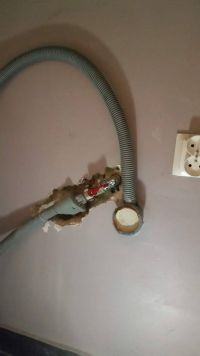vanda_el wrote: This is not what I understand, and where is the siphon in these new washing machines exactly? This is a serious question

I can't imagine it, or maybe there is no need for me to do this miracle. Please explain to the poor woman.
Do you know more or less the design of the washing machine? Regardless of the manufacturer, it looks the same. The metal drum is mounted on a shaft, where a plastic water tank is mounted on the bearing. Under the drum, in the tank, there is a connector to which a drain hose is connected. The hose goes down and connects to the filter, then goes to the pump and drain. This construction forms a u-tube - siphon.
vanda_el wrote: It turned out that the 50/32 elbow pressed deep into the trimmed collar completely blinds the hole from above, immortal silicone for all this and should play
Should but will it be? Such mending always takes revenge. It is best to pull this pipe fi 50 out of the T-piece and install a new one. If the goblet is broken there, it will not seal properly. Silicon based drilling is the worst thing you can do.
There is a plasterboard there, so you can cut a piece, replace the pipe and install the same piece cut from the new board, putty and paint. This is a work day, including plaster drying. Then you can easily install the pipe siphon and you will not need to use balls.
wiesiekmisiek wrote: This ball siphon will completely cut off the odor path from the installation even when the washing machine is not connected.
When we use a pipe siphon and a pipe with a connector for connecting a hose, we also have the same option. Just a rubber plug sold in a set with a tube. The advantage is that the pipe siphon does not require cleaning.
The filter in front of the pump catches larger items, threads and sludge accumulate in the siphon.
 Hello.
Hello. 


